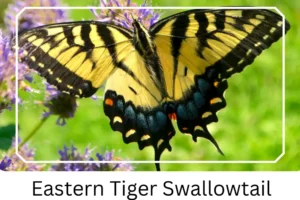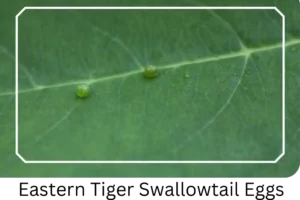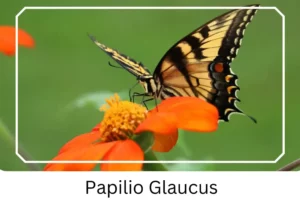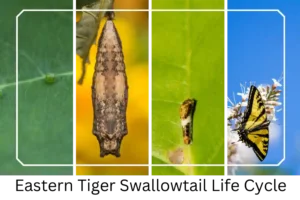Eastern Tiger Swallowtail (Papilio glaucus)
The Eastern Tiger Swallowtail, a striking and widely recognized member of the swallowtail family, graces the eastern regions of the United States with its vibrant presence. Known for its distinctive yellow and black striped appearance, which mirrors the fur pattern of a tiger, this butterfly species adds a dash of color and elegance to various landscapes across its range.
Scientific Classification
- Family: Papilionidae
- Genus: Papilio
- Scientific Name: Papilio glaucus
Overview
Belonging to the genus Papilio, the Eastern Tiger Swallowtail exhibits a fascinating life cycle and adaptability to diverse habitats. Its lifecycle stages, from the vividly patterned caterpillar to the majestic adult butterfly, showcase nature’s wonders in metamorphosis. Inhabiting woodlands, urban parks, and gardens, this butterfly not only contributes to the beauty of its environment but also plays a crucial role in pollination.
Description and Identification
Caterpillar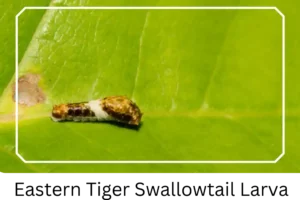
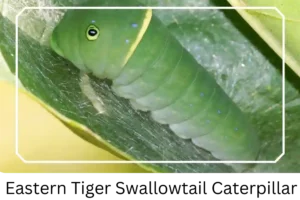
In its early stages, the caterpillar exhibits a white and brown camouflage, which transitions to a striking green with blue, yellow, and black eyespots on its thorax as it matures. This clever coloration serves as a deterrent against predators.
Pupa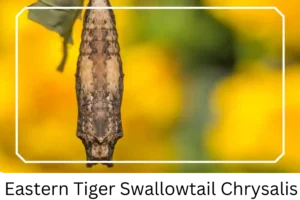
The chrysalis stage of the Eastern Tiger Swallowtail can vary in color, appearing either white or dark brown, depending on environmental factors. This camouflage aids in its survival during the vulnerable stage of metamorphosis.
Adult Butterfly
Sexual Dimorphism: A notable feature of this species is the sexual dimorphism evident in the adult butterflies. Males and females display distinct color patterns that contribute to their identification.
Color and Appearance: When the wings are spread, males boast a bright yellow color with four black stripes, while females may be yellow like the males or exhibit a darker, almost black hue with similar striping. Both genders have blue spots on the hind wings, adding to their allure.
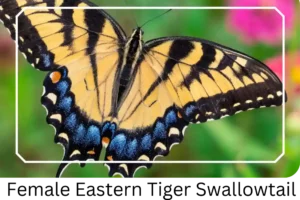
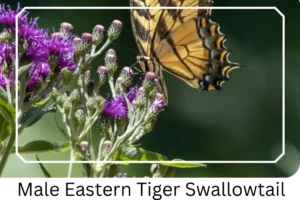 Average Wingspan: The Eastern Tiger Swallowtail has an impressive wingspan ranging from 7.9 to 14 cm (3.1 to 5.5 inches), making it one of the larger butterfly species in its habitat.
Average Wingspan: The Eastern Tiger Swallowtail has an impressive wingspan ranging from 7.9 to 14 cm (3.1 to 5.5 inches), making it one of the larger butterfly species in its habitat.
Flight Pattern: Characterized by erratic and fast flight, this species makes multiple flights annually, adapting its patterns to the geographic location and season.
Quick Facts | |
| Distribution | Ranges across eastern North America, from Southern Ontario to the Gulf Coast, northern Mexico, and New Hampshire. |
| Habitat | Prefers woodlands, riversides, urban parks, and gardens, showcasing its adaptability. |
| Lifespan of Adults | Approximately one month, highlighting the ephemeral nature of their beauty. |
| Host Plants | Includes a variety of plants like wild black cherry and tulip poplar, indicating a diverse diet. |
| Adult Diet | Primarily nectar from flowers such as milkweed and lilac, though it has a versatile palate. |
How to Identify Eastern Tiger Swallowtail?
Identifying the Eastern Tiger Swallowtail is a rewarding experience for nature enthusiasts. Adults are easily recognizable by their large wingspan and the striking yellow and black coloration. Males have a more uniform yellow background with black stripes, while females may vary from yellow to black, mimicking the poisonous pipevine swallowtail for protection. The presence of blue spots on the hind wings of both sexes is a distinctive marker. Caterpillars can be identified by their green color and unique eyespots designed to mimic predators. Observing these features in their natural habitats, such as woodlands and gardens, can provide a fascinating insight into the world of these beautiful creatures.
Did You Know?
- The Eastern Tiger Swallowtail is noted for its polyphagous diet, consuming not just nectar but also carrion and other unusual substances.
- It holds the honor of being the state butterfly or insect for several states, symbolizing its cultural significance.
- The mimicry strategy of the female butterfly, resembling the toxic pipevine swallowtail, is a fascinating example of nature’s defense mechanisms.
Conclusion
The Eastern Tiger Swallowtail butterfly is more than just a pretty face in the insect world. Its unique life cycle, feeding habits, and role in the ecosystem make it a subject of interest for scientists and nature lovers alike. By understanding and appreciating these magnificent creatures, we can take steps to protect their habitats and ensure their survival for generations to come.

